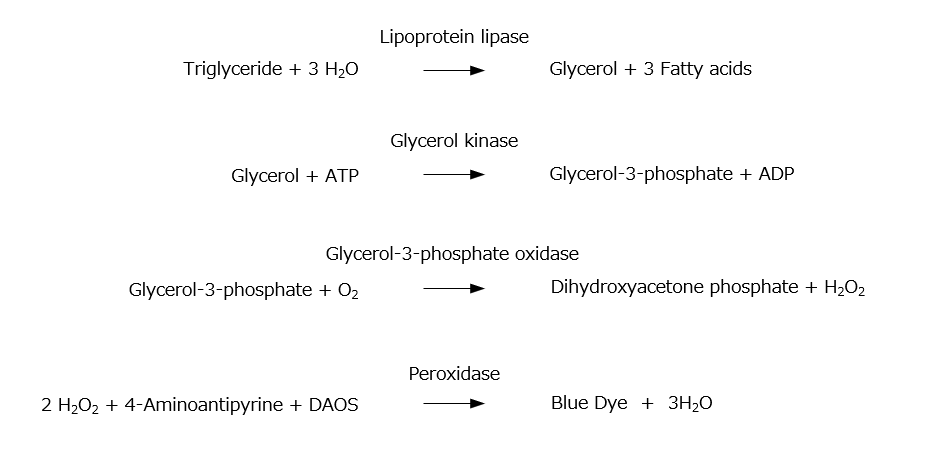Triglyceride Assay Kits
Triglycerides (TGs) are compounds formed by the esterification of three fatty acid molecules with the hydroxyl groups of glycerol (glycerin). Triglycerides are also known as neutral fats or triacylglycerols. They function as an energy source stored in the body, primarily in the liver and adipose tissue. Hyperlipidemia is a condition in which the serum level of lipids, such as cholesterol and triglycerides, is increased. It is classified based on the increased lipid components. Hyperlipidemia is one of the risk factors for ischemic heart disease and cerebrovascular disease.
LabAssay™ Triglyceride is a kit used for the determination of triglycerides in samples using the GPO-DAOS method. With the use of a microplate, this kit provides a quick and convenient method for measuring free fatty acids in samples.
What is Triglycerides?
Triglycerides (TGs) are compounds formed by the esterification of three fatty acid molecules with the hydroxyl groups of glycerol (glycerin). Triglycerides are also known as neutral fats or triacylglycerols and function as an energy source stored in the body, primarily in the liver and adipose tissue. The figure below shows tripalmitin, a triglyceride in which three molecules of palmitic acid are bound to glycerol. The properties of triglycerides vary depending on the hydrocarbon chain length of the fatty acids and the position and number of double bonds.

Triglycerides exist in the blood as lipoproteins. The density of lipoproteins varies depending on their composition. They are classified into chylomicrons, very low-density lipoproteins (VLDL), intermediate-density lipoproteins (IDL), low-density lipoproteins (LDL), and high-density lipoproteins (HDL) (Table 1). The sources of triglycerides in the blood include exogenous (dietary) and endogenous (synthesized in the body) triglycerides. Exogenous triglycerides are mainly found in chylomicrons, while endogenous triglycerides are mainly found in VLDL1). Chylomicrons are present in plasma after meals and are usually not present in the plasma during fasting2). Conversely, VLDL is usually present in plasma in the fasted state2).
| Lipoproteins | Chylomicron | VLDL | IDL | LDL | HDL | |
|---|---|---|---|---|---|---|
| Diameter (Å) | 1,000-10,000 | 700 | 250 | 150 | 75-100 | |
|
Composition (%) |
Protein | 2 | 10 | 10 | 25 | 50 |
| Phospholipid | 3 | 18 | 20 | 15 | 23 | |
| Cholesterol | 5 | 12 | 30 | 50 | 20 | |
| Triglyceride | 90 | 60 | 40 | 10 | 5 | |
Methods of Triglycerides Measurement
In hyperlipidemia, the level of lipids in the serum, such as cholesterol and triglycerides, is increased. Hyperlipidemia is classified based on the increased lipid components3). It is one of the risk factors for ischemic heart disease and cerebrovascular disease.
LabAssay™ Triglyceride is a kit based on an enzymatic colorimetric method (GPO-DAOS method) using the Trinder reagent. With the use of the enzymes and a microplate, this kit provides a convenient method for measuring triglycerides in samples.
Principle of the Triglycerides assay using GPO-DAOS method
Triglycerides in the sample are broken down into glycerol and fatty acids through the action of lipoprotein lipase (LPL). Glycerol is then converted into glycerol-3-phosphate by glycerol kinase (GK) in the presence of ATP. The resulting glycerol-3-phosphate is oxidized by glycerol-3-phosphate oxidase (GPO), simultaneously producing hydrogen peroxide. The resulting hydrogen peroxide induces oxidative condensation of 4-aminoantipyrine and DAOS through the action of peroxidase (POD), producing a blue dye. The absorbance of this blue dye is measured to determine the concentration of triglycerides in the sample.

LabAssay™ Triglyceride
LabAssay™ Triglyceride is a kit used for the determination of triglycerides in samples using the GPO-DAOS method. With the use of a microplate, this kit provides a quick and convenient method for measuring free fatty acids in samples.
[Note] LabAssay™ series are reagents for research purposes. They cannot be used for diagnostic purposes.
Kit Performance
| Analysis sample* | Mouse Serum/Plasma Rat Serum/Plasma Dog Serum/Plasma Cat Serum/Plasma |
|---|---|
| Calibration curve range | 100-888 mg/dL |
| Sample volume | 2 μL |
| Measurement duration | Approx. 10 min |
| Wavelength | Primary wavelength 600 nm Reference wavelength 700 nm |
* Measurement in animal cell culture supernatants4) , cell lysates5-6) and tissue lysates7-8) has been also reported.
References
- Okumura, N., Tozuka, M., Honda, T. and Yatomi, Y.: “Manual of Clinical Laboratory Medicine 35th ed.”, Kanehara shuppan, (2010). (Japanese)
- Fukui, I.: Japanese Journal of Clinical Chemistry, 10(1), 17(1981).
Determination Method of HDL-Cholesterol and Its Clinical Significance (Japanese) - Mizutani, H.: Journal of Pet Animal Nutrition, 13(1), 12(2010).
Lipid metabolism and hyper lipidemia (Japanese) - Kobayashi, T. and Fujimori, K.: Am. J. Physiol. Endocrinol. Metab., 302(12), E1461(2012).
Very long-chain-fatty acids enhance adipogenesis through coregulation of Elovl3 and PPARγ in 3T3-L1 cells - Fujimori, K. et al.: Prostaglandins. Other Lipid Mediat., 94, 96 (2011).
Niacin promotes adipogenesis by reducing production of anti-adipogenic PGF2α through suppression of C/EBPβ-activated COX-2 expression - Funakoshi, T. et al.: Biochem. Biophys. Rep., 13, 39 (2018).
Quercetin inhibits adipogenesis of muscle progenitor cells in vitro - Kato, H. et al.: J. Hepatol., 60, 1032 (2014).
MMP-9 deficiency shelters endothelial PECAM-1 expression and enhances regeneration of steatotic livers after ischemia and reperfusion injury - Gao, F. et al.: Evid. Based Complement. Alternat. Med., 2015, 801291 (2015).
Effect of keishibukuryogan on genetic and dietary obesity models
Product List
- Open All
- Close All
LabAssay™ Triglyceride
For research use or further manufacturing use only. Not for use in diagnostic procedures.
Product content may differ from the actual image due to minor specification changes etc.
If the revision of product standards and packaging standards has been made, there is a case where the actual product specifications and images are different.



